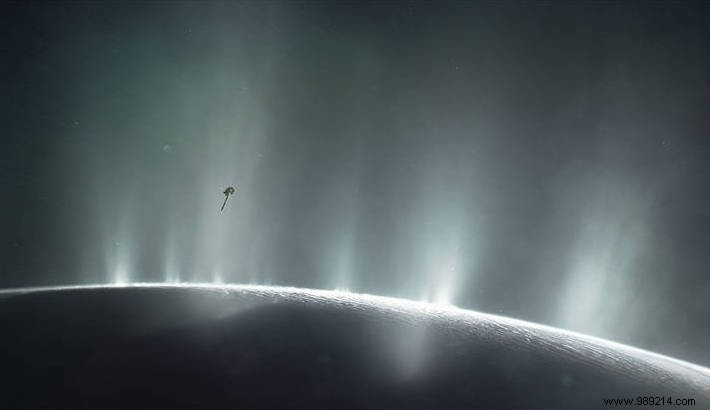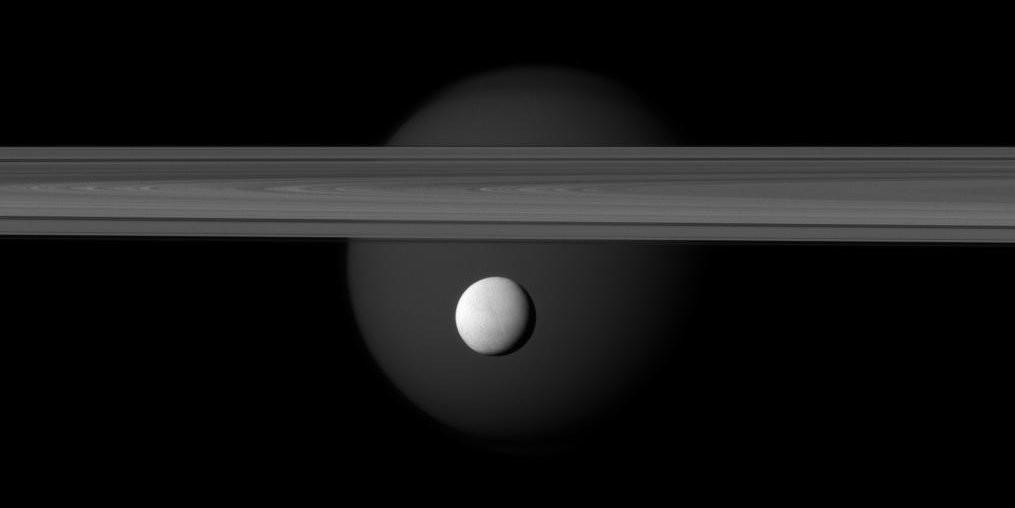According to a new study, the global ocean of the moon Enceladus is not homogeneous. Currents very similar to those on Earth could flow there under twenty kilometers of ice.
Enceladus, Saturn's sixth largest moon, is a small ball of ice 500 kilometers in diameter. Despite its size, the object has attracted the attention of researchers since 2014. We know, thanks to the American probe Cassini, that steam jets emanate from its depths, suggesting the presence of a global ocean below the surface .
The ocean of Enceladus remains quite different from those of Earth. Our oceans are relatively shallow (an average of 3.6 km deep), cover about three quarters of the surface, are warmer at the top thanks to the sun's rays and colder in the depths.
Enceladus, for its part, displays an a priori global ocean about thirty kilometers deep nestled under several kilometers of ice . This mass of water is therefore cooled at the top, near the ice shell, and warmed at the bottom by the heat of the moon's core.
Despite these differences, the ocean of the moon and those of the Earth also display some similarities. We know for example that they are salty . A few months ago, a study also revealed similarities in pH level . Finally, according to a new analysis, the oceans of Enceladus could also have currents similar to those of Earth .
This new work, led by Caltech graduate student Ana Lobo, is based on Cassini measurements as well as research by Andrew Thompson. A professor of environmental science and engineering, he studied how ice and water interact to drive the mixing of the oceans around Antarctica.

As said above, the oceans of Enceladus and Earth share an important characteristic:they are salty. And as these results, published in Nature Geoscience, show us, variations in salinity could serve as drivers for Enceladus' ocean circulation, just as they do in Earth's Southern Ocean around Antarctica.>
Gravitational measurements and heat calculations by Cassini have indeed already revealed that the frozen shell of the moon is thinner at the poles than at the equator . As Andrew Thompson points out, there would therefore be more melting at the level of the polar regions and more freezing at the level of the equator.
However, salt water that freezes tends to release salts into the environment, which weighs down the surrounding water, causing it to sink. The opposite effect occurs at the poles.
"Knowing the ice distribution allows us to constrain traffic patterns “Summarizes Ana Lobo. "Our computer model suggests that regions of freezing and melting, identified by the structure of the ice, would be connected by ocean currents . This would create a pole to equator circulation that influences the distribution of heat and nutrients “.

Remember that a few months ago, a study announced the presence of ammonia (a potential source of fuel for life) in this ocean. Recent work has also pointed out that Enceladus' ocean may be old enough to allow organisms to grow, but not "too old" to sustain it.
We also know that this moon features hydrothermal activity near the core-mantle boundary. However, micro-organisms evolve in similar environments at the bottom of the terrestrial oceans .
Add to that ocean currents that can distribute heat and nutrients, and you have a prime target for astrobiologists looking for signs of life.